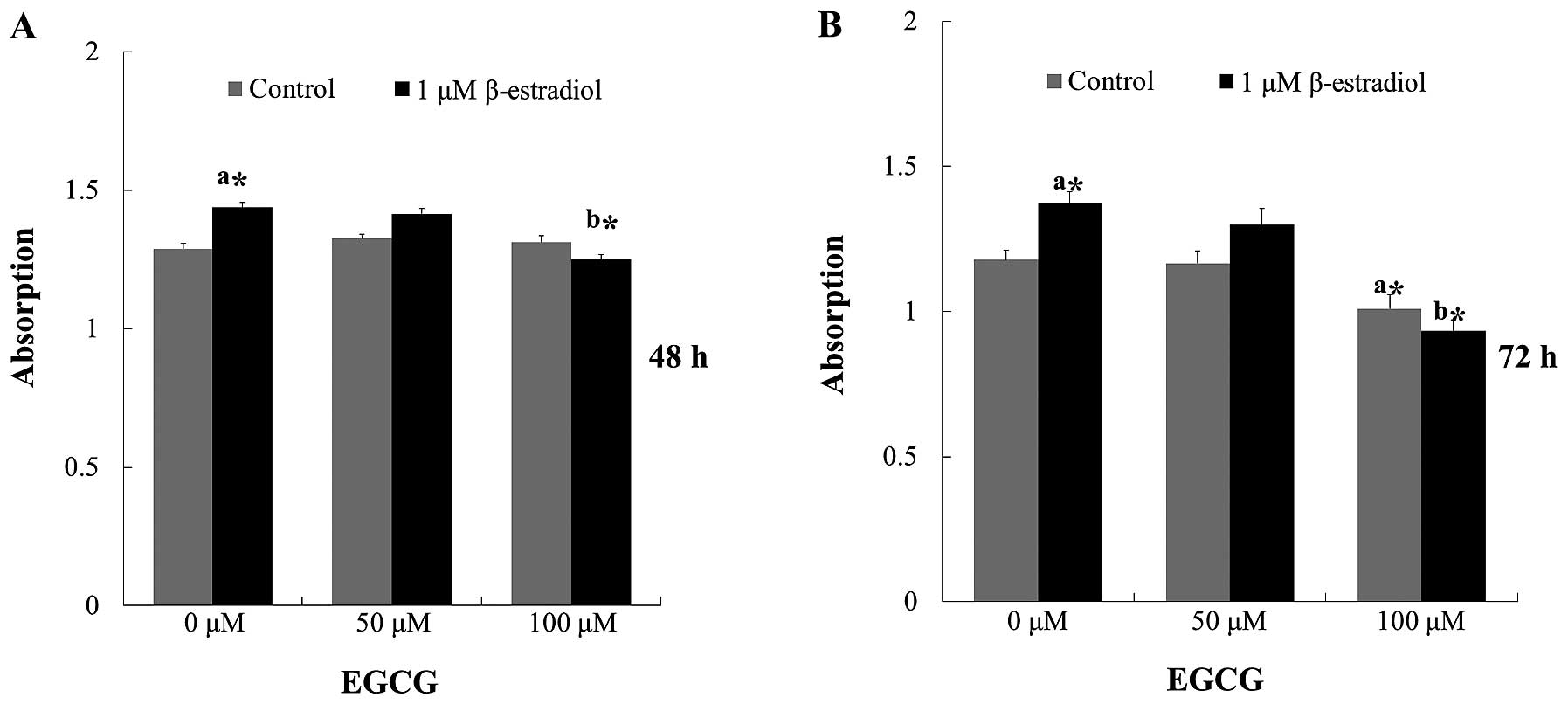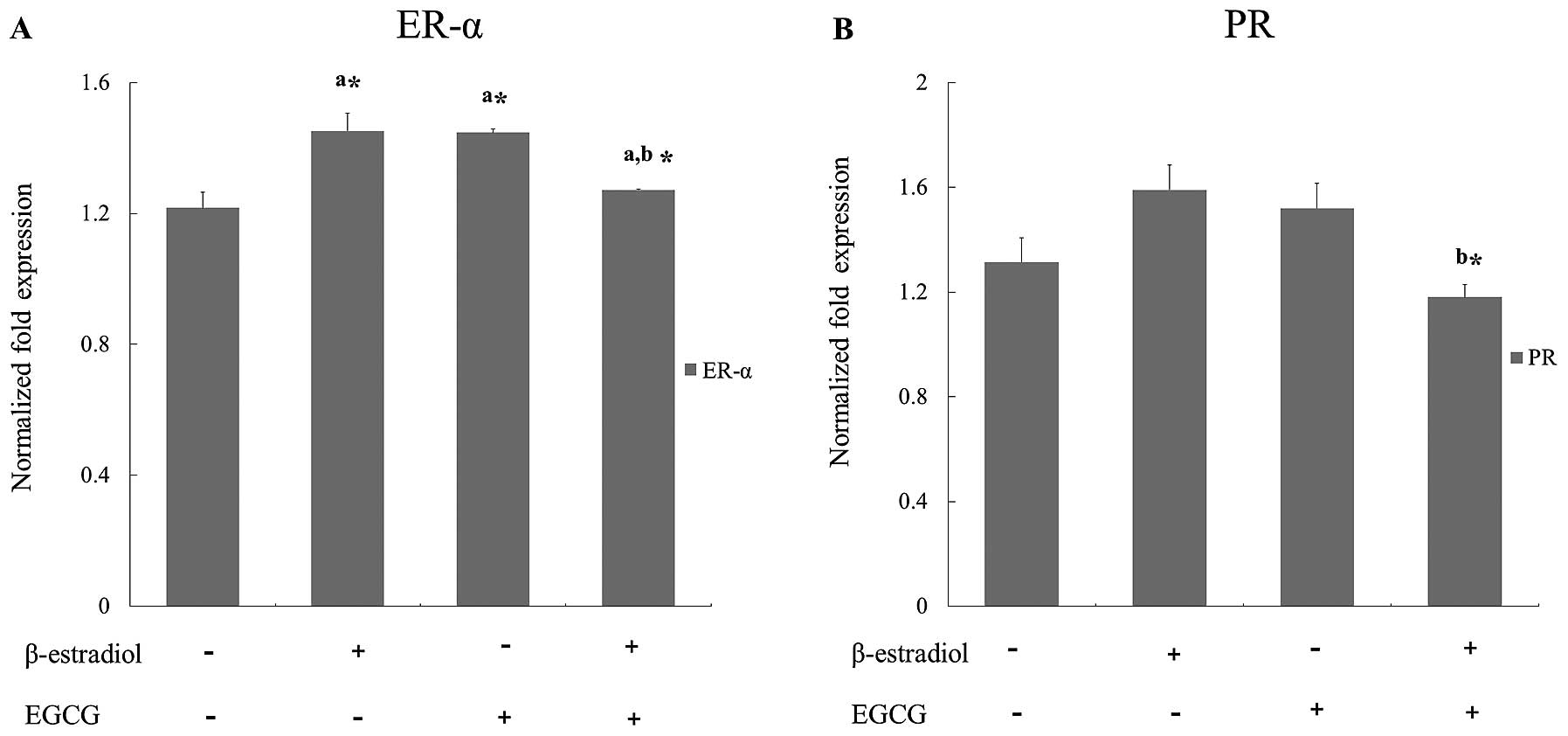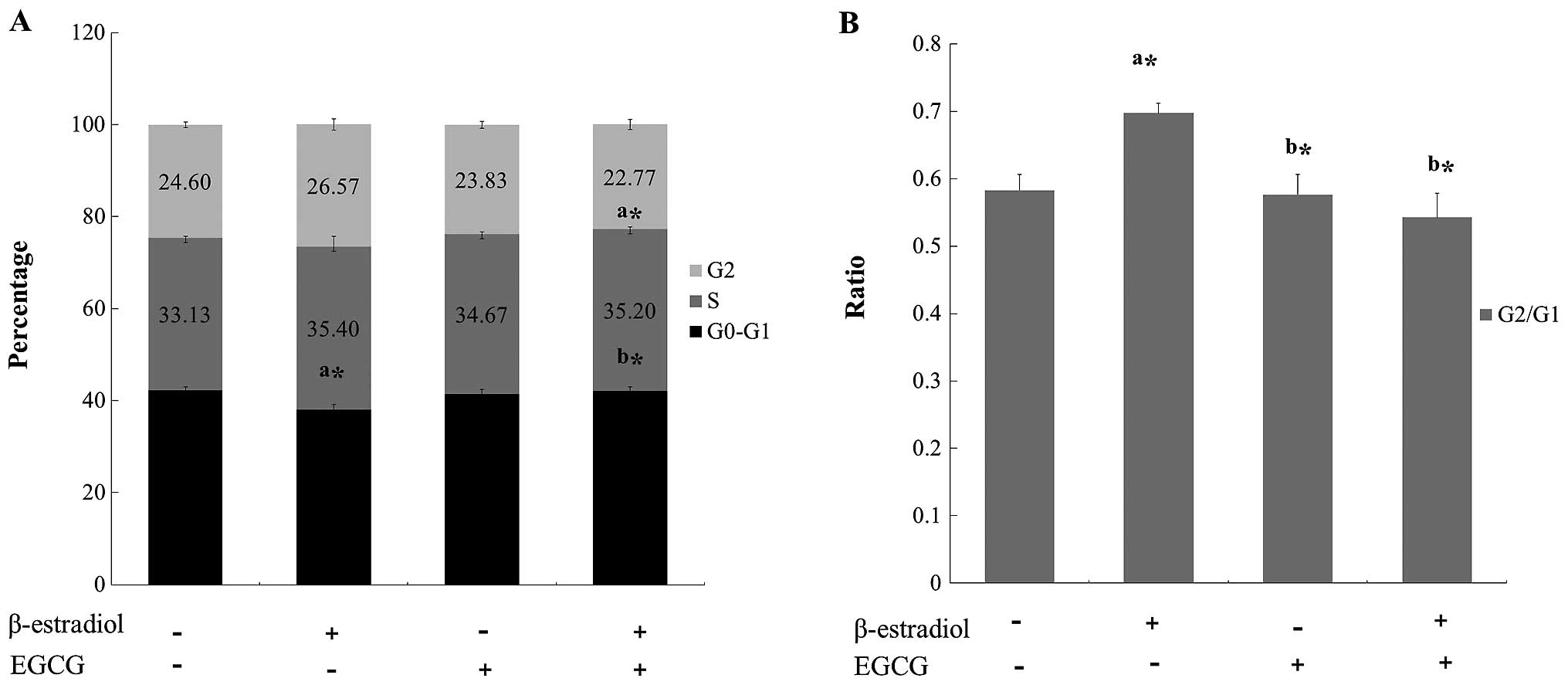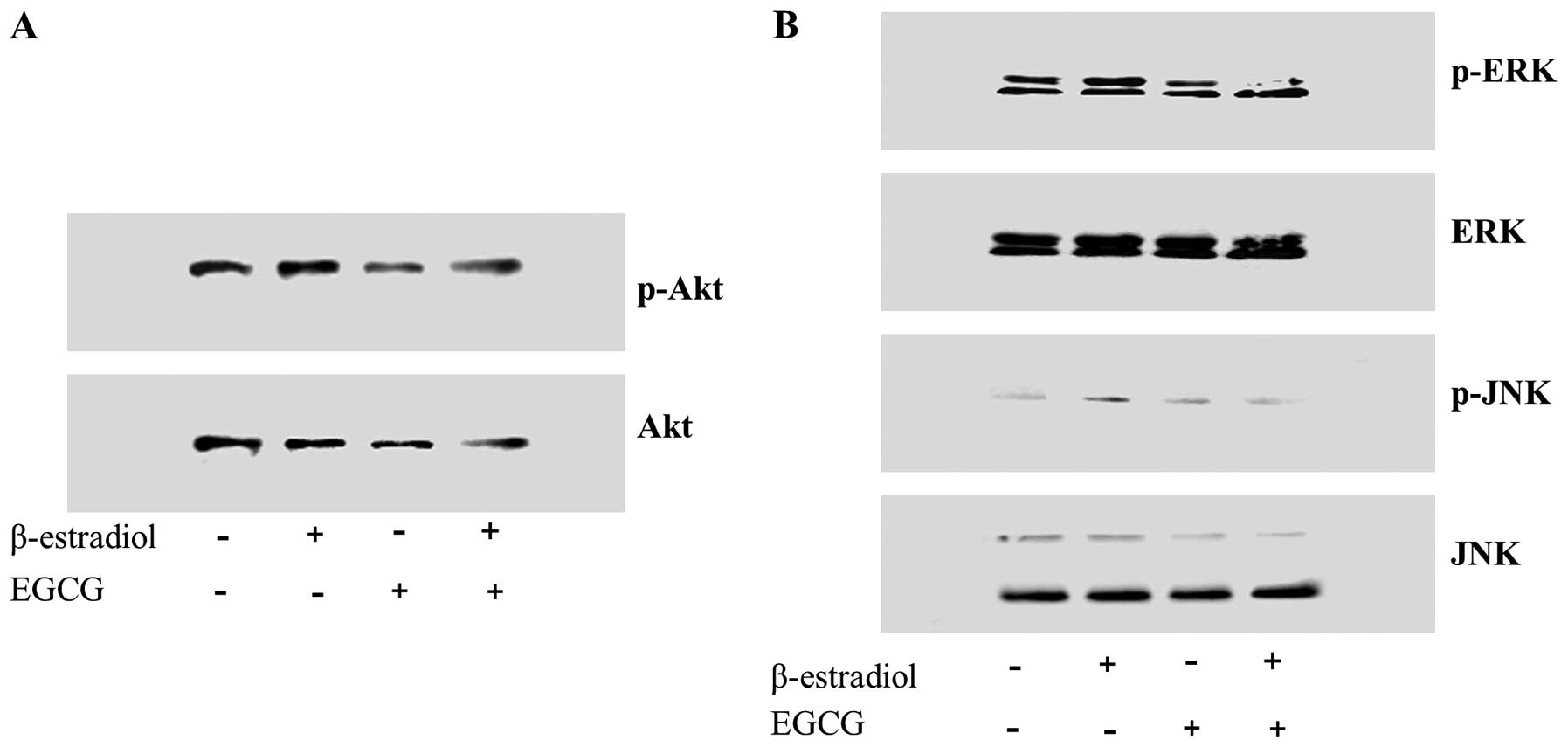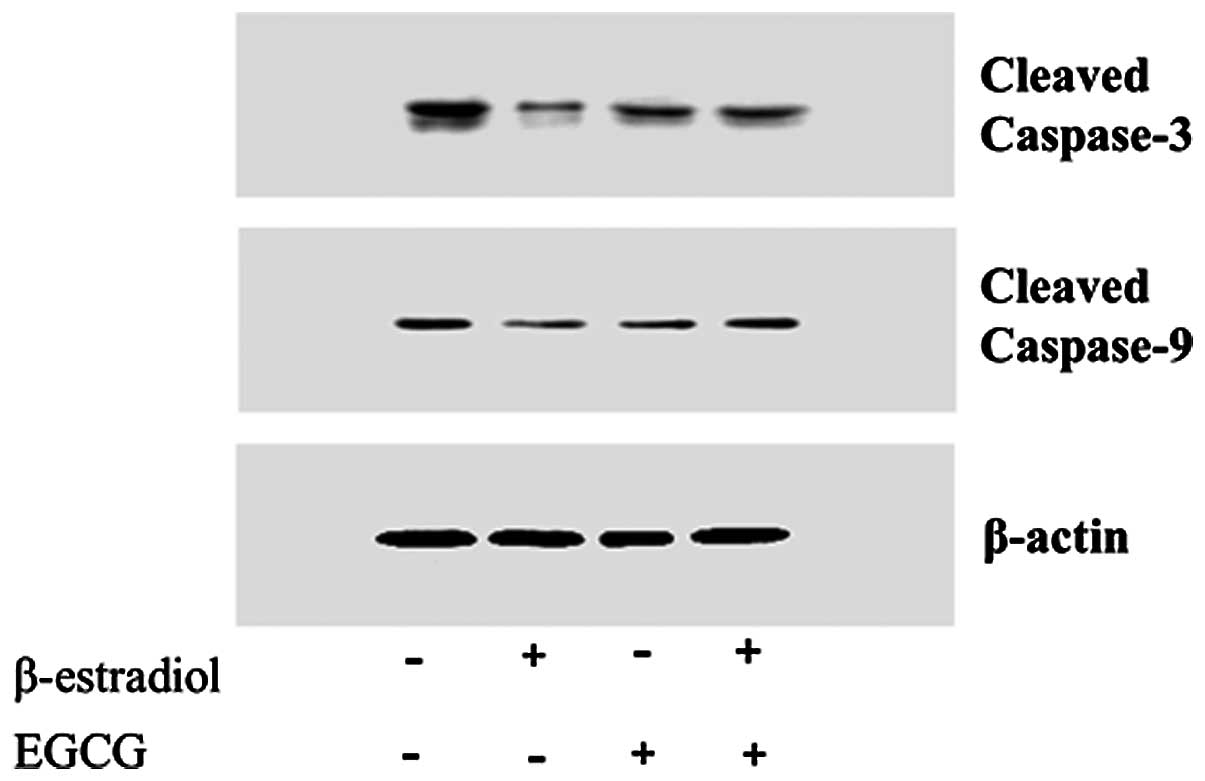Antiproliferative and apoptotic effect of epigallocatechin-3-gallate on Ishikawa cells is accompanied by sex steroid receptor downregulation
- Authors:
- Published online on: August 20, 2012 https://doi.org/10.3892/ijmm.2012.1104
- Pages: 1211-1218
Abstract
Introduction
Endometrial cancer is the most common gynecological malignancy in western countries, and its incidence has recently increased (1). The risk factors of endometrial adenocarcinoma include nulliparity (2), late menopause onset (3) and use of estrogen-only hormone replacement therapy (HRT) (4). An exposure to high estrogen and low progesterone levels increases proliferation of endometrial cells, and therefore the risk of cancer development of endometrial adenocarcinoma (5).
Among various risk factors, estrogens are well recognized to play a significant role in endometrial cancer development and growth (6). Estradiol has been shown to exert its proliferative and anti-apoptotic effects through the Akt activation in human endometrial cells (7). Estrogen acts via the estrogen receptor, which hormone induce the estradiol activation of the estrogen signal members and their mutual communication (8).
Estrogen receptor and progesterone receptors belong to the steroid hormone nuclear receptor superfamily and their upregulation in Ishikawa cell is induced by estradiol treatment (9). They are ligand-activated transcription factors involved in hormone-mediated signaling, hormone-mediated gene expression, and cellular proliferation and differentiation.
MAPK pathway is involved in the control of many fundamental cellular functions that include cell proliferation, survival, differentiation, apoptosis and metabolism (10).
Green tea has been studied extensively for its health benefits, including anticancer and cancer chemopreventive properties (11). Green tea contains a variety of polyphenols known as catechins. (−)-epigallocathechin-3-gallate (EGCG) is a major component of polyphenols in green tea (12). EGCG interacts with various molecules such as proteins, transcription factors, and enzymes, which block multiple stages of carcinogenesis via the regulation of intracellular signaling transduction pathways. EGCG possesses pharmacological and physiological properties including induction of phase II enzymes, mediation of anti-inflammation response, regulation of cell proliferation and apoptosis effects and prevention of tumor angiogenesis, invasion and metastasis (13). However, the EGCG amounts used in previous studies seem too high to explain the anticancer effect associated with green tea, compared with the levels measured in human blood and serum after oral consumption (14). Several mechanisms of cancer inhibition by EGCG in vivo have been proposed. It is reported that EGCG inhibited angiogenesis and matrix metalloproteinase in vivo (15). It is also reported that EGCG prevented the carcinogenesis of cervical cancer, induced apoptosis and inhibited telomerase activity (16).
The present study was undertaken to evaluate antiproliferative effects on human endometrial adenocarcinoma cell line, Ishikawa cell under the influence of EGCG. The anti-proliferative mechanism of action of EGCG was determined by studying the ER-mediated signaling and modulation of downstream genes involved in cell proliferation and apoptosis. We report that EGCG inhibits proliferation via modulating ER-dependent signaling mechanisms, interfere with Akt activation and induce apoptosis via intrinsic and extrinsic pathway in human endometrial cancer cells.
Materials and methods
Reagents and cell culture
Antibodies for caspase-3, -9, Akt, ERK, P38 and each phospho-form were purchased from Cell Signaling Technology. Enhanced chemiluminescence (ECL) was obtained from ELPIs Biotechnology, and other reagents were purchased from Sigma Chemical Co. (St. Louis, MO, USA). SYBR green was purchased from Agilent Technologies, and Tri reagent was purchased from Invitrogen (Carlsbad, CA). Human endometrial adenocarcinoma (Ishikawa) cells, which were kindly gifted by Dr Y.H. Kim at Asan Medical Center, Seoul, Korea, were grown in DMEM-F12 (Gibco, Invitrogen) supplemented with 10% FBS at 37°C in 5% CO2. Passages 4–8 of cultures were used in all experiments.
Cell proliferation assay
The effects of EGCG on Ishikawa cells were assessed by MTT assay. Ishikawa cells (1×104 cells/ml) were incubated in a 96-well. The cells were incubated with EGCG, and cultured at 37°C under humidified atmosphere with 5% CO2 for 24 h. Subsequently, 20 μl MTT solution (5 mg/ml in PBS) was added to each well and placed at room temperature for 4 h. The absorbance was measured on an ELISA reader at a wavelength of 495 nm.
Reverse transcription-polymerase chain reaction (RT-PCR)
RT-PCR was used to analyze the expression of mRNA for cell cycle factors, apoptosis factors and β-actin (internal control) in estrogen-stimulated Ishikawa cells. The Ishikawa cells were treated with 100 μM EGCG and 1 μM E2 for 24 h, and total RNA was isolated using Tri-reagent. cDNA was generated from 0.2 μg of total RNA using RevertAid First strand cDNA Synthesis kit (Fermentas, St. Leon-Rot, Germany). The primers used for amplification of each gene were as shown in Table I. Real-time PCR was performed on Applied Biosystems 7000 real-time PCR system (Life Technologies, Carlsbad, CA, USA) with SYBR green premix. The expression levels of genes were normalized to that of β-actin gene.
Western blot analyses
For immunodetection, cells were harvested and lysed in lysis buffer consisting of 20 mM Tris, 137 mM NaCl, 2 mM EDTA, 10% glycerol, 1% Triton X-100, Protease inhibitor (Sigma Chemical Co., MO, USA), and phosphatase inhibitor cocktail III (Calbiochem Co., USA). The cleared protein lysates were separated by 12% SDS-PAGE and transferred electrophoretically onto nitrocellulose membrane. Blots were blocked with 3% non-fat dry milk in TBS, them incubated with primary antibody. The Akt, ERK, JNK, caspase-3 and-9 were assayed using anti Akt, ERK, JNK, caspase-3 and -9 antibody (Cell Signaling Technoligy, MA, USA). After washing, blots were incubated with anti-goat horseradish peroxidase-conjugated secondary antibodies for 1 h. Immunodetection was carried out using an enhanced chemiluminescence peroxidase substrate solution (ELPIs Biotechnology, Taejeon, Korea). Each band was analyzed by densitometry for statistical comparisons.
Cell cycle analysis
Cells were seeded in 6-well plates and treated with EGCG and E2 for 24 h. After treatment, cells were washed with PBS, fixed in 70% cold ethanol for 72 h, and then stained with propidium iodide (PI) solution (50 μg/ml). Cell cycle distribution was analyzed with flow cytometry (Beckman Coulter Inc., Brea, CA, USA). The percentage of DNA content at different phases of the cell cycle was analyzed with Multicycle-software.
Annexin-V/propidium iodide labeling and flow cytometry assay
Annexin-V binding is indicative of early apoptosis (17). The cells were culture in 6-well plates and treated with EGCG for 24 h. Adherent and non-adherent cells were probed with FITC-conjugated Annexin-V and PI (BD Bioscience, NJ, USA) for 15 min. The staining profiles were determined with FACScan. Stained cells were observed by fluoromicros-copy (Zeiss, Oberkochen, Germany). The experiments were performed three times with three replicates in each.
Statistical analysis
The data are expressed as the mean ± SD. The statistical significance of the difference in mean values was tested using one-way analysis of variance (ANOVA) and Student’s t-test. Significance was defined as P<0.05.
Results
EGCG inhibits Ishikawa cell proliferation
To investigate the effect of EGCG on Ishikawa cell stimulated with E2, we applied EGCG and E2 for 24, 48, and 72 h. Inhibitory effects were not found at 24 h, treated with 50 and 100 μM of EGCG (data not shown). Comparable results were found for E2-stimulated cells which were significantly increased at 48 and 72 h, this effect could be inhibited by treatment with EGCG, and high concentration of EGCG also inhibited cell proliferation without E2 treatment (Fig. 1). Therefore, 100 μM EGCG treatment was selected for further experiments.
Effect of EGCG on the expression of estrogen and progesterone receptor
For the analysis of ER-α and PR expression differences, cells treated with EGCG were incubated with or without 1 µM E2 for 24 h. E2 treatment induces association of estrogen receptor α (8). As shown on Fig. 2, E2 treated cells showed increased expressions of ER-α and PR. However, the increased expressions were strongly inhibited by EGCG with statistical significance.
EGCG induces cell cycle arrest in Iishikawa cells
To examine the mechanism responsible for EGCG mediated cell proliferation inhibition, cell cycle distribution was evaluated using flow cytometric analysis. The results showed that EGCG treated cells caused a significant inhibition of cell cycle progression in Ishikawa cells (Fig. 3). Cyclin D and Cdk 4 genes are responsible for the transition of cells from G1 phase. Cyclin A and Cdk 2 genes are from S phase, and cyclin B and Cdk 1 genes are from M phase. Real-time PCR analysis showed that mRNA expression level of G1-Cdk, M-Cdk, and S-Cdk genes were decreased after EGCG treatment (Table II). These results clearly showed that EGCG induced cell cycle arrest through the control of cyclin-Cdk complexes.
EGCG disturbs the Akt pathway in Ishikawa cell proliferation treated with E2
In case of estrogen-dependent cells, estrogen induces cell proliferation and metabolic activity via PI3K-Akt signal and its downstream mitogen activated protein kinase (MAPK) (8). To study the effect of EGCG on Akt cell survival pathway, phosphorylation status of Akt and expression of its downstream signal MAPK was studied in Ishikawa cells (Fig. 4). Immunoblots showed that EGCG decreased the intracellular levels of phosphorylated Akt (Fig. 4A), and Akt downstream MAPK, ERK and JNK also decreased. Estrogen receptor belongs to steroid hormone nuclear receptor super-family, and they are ligand-activated transcription factors involved in cellular proliferation and differentiation. They are translocated from the plasma membrane to the nucleus and are mediated by MAPK activation (1). This suggests EGCG regulate cell proliferation by the Akt signal and MAP kinase activation.
EGCG induces apoptosis in Ishikawa cells
We next assessed the effect of EGCG on the induction of apoptosis in Ishikawa cells by FACS analysis. To analyze the apoptosis quantitatively, Ishikawa cells treated with EGCG were examined by flow cytometric analysis to determine the total DNA content of each cell (Fig. 5A). In the present study, we observed that EGCG treatment increased the apoptotic regions of T2 and T4 through the accumulation of sub-G1 cells (Fig. 5B).
EGCG induces apoptotic genes in Ishikawa cells
After EGCG treatment of Ishikawa cells, apoptosis-related proteins, such as caspase-6, 8, 10, Bcl-2, and Bax, were upregulated in E2 treated cells. The results revealed that EGCG causes significant downregulation of the anti-apoptotic gene, Bcl-XL (Table III). By quantification of Bax and Bcl family mRNA, it was found that EGCG increase the Bax/Bcl family ratio. EGCG may induce apoptosis by altering the Bax/Bcl family ratio and controlling the initiating caspases. Western blot analysis showed that EGCG increased the level of cleaved caspase-3 and -9 (Fig. 6).
Discussion
In agreement with previous experimental studies demonstrating the anticancer effect of EGCG using various cell lines, we also found that EGCG had anticancer effect on an endometrial cancer cell line in vitro. Endometrial cancer is one of the most significant gynecological malignancies in the world and accounts for almost 50,000 deaths worldwide per year (18). It is well known that estrogen plays an important role in carcino-genesis of endometrial cancer. There have been many studies demonstrating the relationship between unopposed estrogen exposure and endometrial cancer occurrence (4,19). EGCG, one of the major catechins in green tea, is found in 50–80% of green tea and shows anticancer properties through blocking multiple signaling pathways, thereby causing strong cancer chemopreventive effects (23). Although the anticancer effects of EGCG has been reported in many studies, we could not find the molecular mechanisms on endometrial cancer cells. Thus, this study is the first trial to verify the anticancer effect of EGCG on an endometrial cancer cell line in vitro.
Ishikawa cells are one of the best characterized of human endometrial cancer cell line derived from a well differentiated adenocarcinoma and expresses functional steroid receptors of estrogen, progesterone, and androgen (20). In the present study, we used 1 μM E2 to induce estrogen receptor upregulation. It would be considered that E2 treatment provides more physiologic environment to the cell culture because the endometrial tissue is grown by estrogen secreted from ovary during reproductive life. Estrogen receptors are upregulated maximally in the late proliferative phase when the serum estrogen level is the highest during the menstrual cycle (21). We found that estrogen and progesterone receptor mRNAs were downregulated in the cells treated with both E2 and EGCG, but not in EGCG only treated cells (Fig. 2). In a previous study on EGCG effect on endometriosis, EGCG inhibited vascular endothelial growth factor (VEGF) expression in endometrial glandular cells and stromal cells stimulated with E2. It was considered that the decreased VEGF expressions might be due to the ability of EGCG competing with E2 for binding to ER-α (21). Considering the lower expressions of ER-α and progesterone receptor mRNA from this study, EGCG might disturb the process of estrogen and progesterone receptor synthesis in the cells stimulated by estrogen. However, more studies would be necessary to obtain the exact mechanism of EGCG on estrogen receptor. Irrespectively, EGCG might be applied as an alternative therapeutic trial to the disorders characterized by estrogen-dependent growth, such as endometriosis, endometrial hyperplasia and breast cancer.
The extracellular signal regulated protein kinases (ERK), the c-NH2-terminal kinases (JNK), and the p38 MAPKs have been considered as three major MAPKs and activated Akt plays a key role in signaling for cell growth, cell survival (anti-apoptotic) and cell cycle progression. We could find that ERK, JNK and Akt phosphorylations were reduced more in the EGCG treated cells than control or E2 only treated cell (Fig. 4). These results suggest that EGCG have inhibitory effects on cell proliferation and differentiation through MAPK and Akt pathway. These findings are consistent with other studies on human colon cancer cells demonstrating that EGCG inhibited the activation of ERK and Akt (22,23).
We analyzed the enzymes involved in apoptosis processes, cleaved caspase-3 and -9. Increased expressions were observed in the cells co-treated with E2 and EGCG, when we compared with E2 only treated cells (Fig. 6). Quantitative real-time PCR was used to compare the expression levels of apoptosis related enzyme and proteins implicated in the cancer cell survival. Caspase-6 and -10 expressions in cells co-treated with E2 and EGCG were increased. Bcl-XL, an anti-apoptotic protein, was decreased, but bcl-2 level was not changed (Table III). Proportions of apoptotic cells treated with EGCG were higher than the control cells regardless of E2 treatment (Fig. 5). These results suggest that EGCG induces apoptosis on Ishikawa cells stimulated with or without E2. Since the apoptotic effect of EGCG on cancer cells published in 1997, subsequent studies verified the effect in various cell types, such as lung, colon, pancreas, skin, and prostate (24,25), but, there have been no report on the apoptotic effect of EGCG on endometrial cancer cells.
Cell cycle dysregulation by cylin-dependent kinase (CDK) activity is generally observed in human malignant cells. In the present study, we found that Cdk1, Cdk2 and cyclin D3 mRNA expressions in ECGC and E2 co-treated cells were decreased, comparing with the cells treated with E2 only (Table II). In flow cytometric analysis, we observed that the percentage of G0/G1-phase cell cycle arrest in EGCG treated cells was more than that of E2 only treated cells (Fig. 3). This fact implies that EGCG inhibits cell cycle progression by decreasing Cdk 1, Cdk 2 and cyclin D3 of cells treated with E2. Therefore, it is suggested that EGCG shows an inhibitory effect on Ishikawa cell cycle progressions as previous studies have been reported (26,27).
Clinical trials to apply EGCG to the cancer patients have been performed. A few studies have reported the effectiveness in human papilloma virus-infected cervical lesion and androgen independent prostate cancer (28,29). In the case of endometrial cancer or estrogen-dependent disease, the present study would provide the beginning of clinical application.
Conclusively, the present study demonstrates for the first time that EGCG inhibits proliferation and induces apoptosis of the endometrial cancer Ishikawa cells in vitro. Estrogen and progesterone receptor expressions are also decreased among the cells co-treated with E2 and EGCG. Thus, EGCG, major component of green tea, might have therapeutic or chemopreventive effect on endometrial cancer or estrogen-related disorders.
Acknowledgements
This study was supported by the Dong-A University Research Fund.



